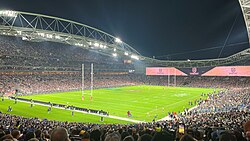| Athletics at the XI Paralympic Games | |
|---|---|
 Host stadium (shown in 2022) | |
| Venue | Stadium Australia |
| Dates | 20 to 29 October 2000 |
| Competitors | 1044 from 104 nations |
Athletics at the 2000 Summer Paralympics comprised a total of 234 events, 165 for men and 69 for women. Athletes were classified according to the extent and type of their disability.
Contents
- Classes 11-13: visually impaired athletes
- Class 20: intellectually disabled athletes
- Classes 32-38: athletes with cerebral palsy; classes 32 to 34 competed while in wheelchairs
- Classes 42-46: amputees and those with other disabilities (les autres)
- Classes 51-58: athletes with spinal cord disabilities; these classes competed while in wheelchairs
Class numbers were preceded by a "T" for track events, an "F" for field events, and a "P" for the pentathlon. Lower respective class numbers corresponded to more severe disability. An exception to this classification scheme arose for athletes with severe cerebral palsy competing in field events; there were no F32 events, so athletes from this category instead competed in class F51 against athletes with spinal cord disabilities. [1]



